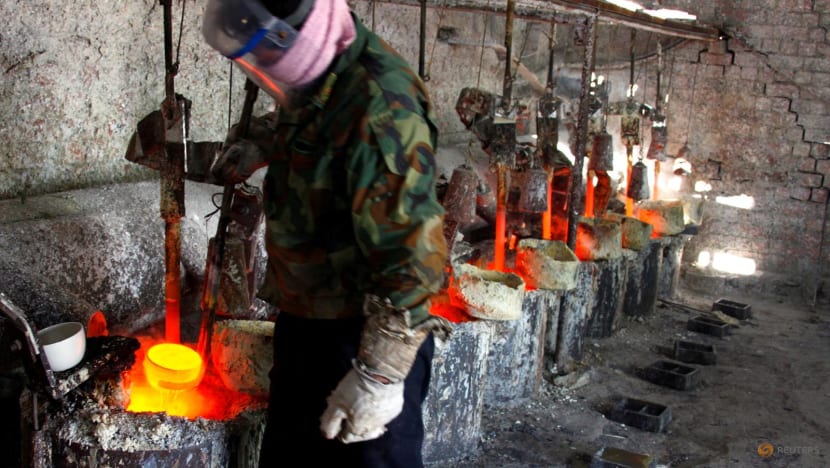Commentary: China’s rare earths heft will define BRICS' role in the world
The BRICS countries constitute a formidable force in the critical minerals sector and have the potential to shape a fair and resilient global resource economy. Much will depend on how China exercises its critical minerals heft, says RSIS' Sarah Soh.

File photo. A worker at a smelting workshop prepares to pour the rare earth metal Lanthanum into a mould near the town of Damao in China's Inner Mongolia Autonomous Region. (File photo: Reuters/David Gray)

This audio is generated by an AI tool.
SINGAPORE: Lately, it seems you can barely go a day without seeing rare earths in the headlines.
On Monday (Oct 20), the United States and Australia signed a multi-billion-dollar deal to boost cooperation on rare earths and critical minerals, as part of efforts to counter China’s dominance of the market. Then on Tuesday, EU’s trade chief Maros Sefcovic announced that China’s Commerce Minister Wang Wentao had accepted an “urgent” invitation to Brussels to talk about Beijing’s tightening of restrictions on rare earths exports.
The critical minerals domain has emerged as a strategic focal point for geopolitical competition. A central motif in the tit-for-tat tariff war between China and the United States has been the “minerals versus chips” battle.
Last year, China suspended exports of key dual-use raw materials to the US in response to American policies which restricted China’s access to advanced semiconductor technologies.
Seven rare earths elements (REEs) were added to the Chinese export controls list in April this year in retaliation against the “reciprocal” tariffs levied by the Trump administration on Chinese goods.
Two weeks ago, China significantly expanded its export controls, broadening the scope to include technologies related to rare earths. It will now also require foreign companies to get its approval to export products manufactured overseas that contain even trace amounts of certain Chinese-processed rare earths.
CAN BRICS SHAPE AN INCLUSIVE GLOBAL RESOURCE ORDER?
China’s moves, though directed at the US, have triggered global repercussions. Automotive and defence manufacturers in Europe and the Asia-Pacific have had to contend with rising costs as well as disruptions to supply chains and production schedules. The vagaries of great power rivalry have thus plagued the global critical minerals market with uncertainties and volatility.
Additionally, attempts by countries to secure resilient strategic minerals supply chains have resulted in a contested and fragmented resource order. The “friendshoring” approach favoured by the US has given rise to several minerals governance initiatives involving the US and its Western allies and partners. These include the Energy Resource Governance Initiative (ERGI), the Minerals Security Partnership (MSP), the Sustainable Critical Minerals Alliance (SCMA) and the Quad Critical Minerals Initiative.
Groupings such as the G7 and the Association of Southeast Asian Nations (ASEAN) have put out action plans detailing collaborations across upstream and downstream phases of the critical minerals value chain and joint efforts to tackle supply chain disruptions among their members.
With critical minerals viewed increasingly through the lens of national security, strategic minerals partnerships have also become integral aspects of bilateral cooperation between “like-minded” countries. Despite the emphasis on multi-stakeholder partnerships and open collaboration in many of these arrangements, the underlying intention is to hedge against China’s control of the critical minerals trade.
In his speech at the 17th BRICS summit hosted by Brazil in July this year, Indian Prime Minister Narendra Modi called on the member states to “work together to make supply chains for critical minerals and technology secure and reliable” and to “ensure that no country uses these resources for its own selfish gain or as a weapon against others”.
This was widely interpreted as an oblique criticism of China’s “weaponisation” of critical minerals. Diplomatic jab aside, Modi’s statement raises an interesting prospect. Can BRICS contribute towards shaping an inclusive global resource order?
BRICS’ DOMINANCE IN THE GLOBAL CRITICAL MINERALS SECTOR
Collectively, the BRICS countries exert considerable influence in the critical minerals sector, with China being the juggernaut.
The Global Critical Minerals Outlook 2025 published by the International Energy Agency pegs China as the world’s top refiner and supplier of key critical minerals. It holds an average market share of around 70 per cent for refined copper and lithium, and a near-monopoly of refined cobalt, graphite and REEs.
China currently produces over 95 per cent of battery-grade graphite and magnet REEs, which are essential materials for electric vehicle motors, consumer electronics and wind turbine energy generators.
Latest data released by the US Geological Survey showed that China, Brazil, India, Russia and South Africa account for approximately 85 per cent of the world’s REEs reserves, with China commanding the largest share at 44 million tons.
Indonesia, the newest entrant to BRICS, is the foremost nickel refiner in the world, although it should be noted that the majority of Indonesian nickel refining assets are owned by Chinese companies.
To realise their ambitions of becoming pivotal players in the global minerals value chain, Saudi Arabia and the United Arab Emirates have invested extensive state-backed resources into mining projects and the development of processing facilities both domestically and overseas.
WHAT WILL A BRICS CRITICAL MINERALS STRATEGY LOOK LIKE?
BRICS has yet to formalise a critical materials strategy and whether the member states can find common grounds to forge a unified stance on the matter remains to be seen. Given their collective weight in the minerals sector, the BRICS countries have the potential to shape the rules and norms of the global resource order.
Granted, BRICS has positioned itself as a leading multilateral platform for Global South countries seeking alternatives to “Western-dominated” systems. However, a minerals strategy that focuses too narrowly on appealing to the interests of the Global South would be a missed opportunity for the grouping to truly “walk the talk” of inclusivity and equity.
A BRICS critical minerals plan should provide space for collaborative partnerships across the whole supply chain with countries from both the Global North and South. As the contours of competing alliances begin to emerge amid the global contest for strategic materials, BRICS is presented with an opportunity to rise above “bloc politics” to build a fair and resilient global resource economy.
THE CHINA FACTOR
The overall direction of a potential BRICS critical resource strategy would depend to a large extent on what China chooses to do with its critical minerals heft. China has thus far brandished the critical minerals card as a bargaining chip to advance its interests.
The US is not the first country to be at the receiving end of China’s REEs power play. In 2010, China implemented a rare earths export ban against Japan following a maritime incident near the disputed Senkaku islands in the East China Sea.
More recently, China had allegedly threatened to block purchases of rare earths from the Kachin Independence Army unless it gave up its plans to capture a strategic town from the Myanmar junta forces.
Rare earths also featured in the calibrated steps towards re-engagement between China and India. During a visit to New Delhi in August for border talks, Indian sources revealed that Chinese Foreign Minister Wang Yi had met with External Affairs Minister S Jaishankar and assured his counterpart that China would address India’s rare earths concerns.
China’s dominance in the world’s critical minerals sector is an opportunity for the country to present itself as a responsible actor and provider of global goods.
At the latest Shanghai Cooperation Organization summit in Tianjin, Chinese President Xi Jinping had announced the Global Governance Initiative and outlined China’s vision of “a fairer and more reasonable system of global governance”. How China wields its critical minerals primacy will be keenly watched.
Sarah Soh is an Associate Research Fellow in the Regional Security Architecture Programme at the Institute of Defence and Strategic Studies, S Rajaratnam School of International Studies, Singapore.



















